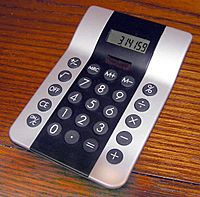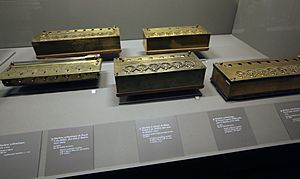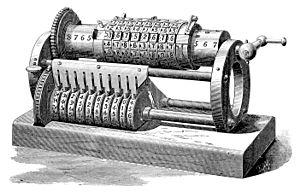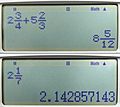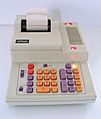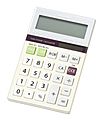Calculator facts for kids
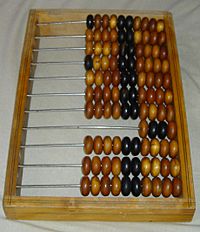
A calculator is a machine which allows people to do math operations more easily. For example, most calculators will add, subtract, multiply, and divide. Some also do square roots, and more complex calculators can help with calculus and draw function graphs. Calculators are found everywhere. A smartphone or other computer can also act as a calculator.
Some calculators, like the abacus, will work without batteries. Others, like the electronic calculator, require batteries. There are two types of electronic calculators: simple calculators, which can only add, subtract, multiply and divide, and sometimes take square roots; and scientific calculators, which can do many other things, such as calculate factorials and trigonometry functions.
There are different ways to write mathematics on a calculator. For example, after pressing "3" and then "+" and then "2" and then "=" (or "ENTER") the number "5" will be displayed on the screen. This is called infix notation. Many more advanced calculators use postfix notation, that is, "3 4 +" instead of "3 + 4 =". The third way of noting things, "+ 3 4", called prefix notation, is rarely found on calculators.
Contents
History
The first known tools used to aid arithmetic calculations were: bones (used to tally items), pebbles, and counting boards, and the abacus, known to have been used by Sumerians and Egyptians before 2000 BC. Except for the Antikythera mechanism (an "out of the time" astronomical device), development of computing tools arrived near the start of the 17th century: the geometric-military compass (by Galileo), logarithms and Napier bones (by Napier), and the slide rule (by Edmund Gunter).
In 1642, the Renaissance saw the invention of the mechanical calculator (by Wilhelm Schickard and several decades later Blaise Pascal), a device that was at times somewhat over-promoted as being able to perform all four arithmetic operations with minimal human intervention. Pascal's Calculator could add and subtract two numbers directly and thus, if the tedium could be borne, multiply and divide by repetition. Schickard's machine, constructed several decades earlier, used a clever set of mechanised multiplication tables to ease the process of multiplication and division with the adding machine as a means of completing this operation. (Because they were different inventions with different aims a debate about whether Pascal or Schickard should be credited as the "inventor" of the adding machine (or calculating machine) is probably pointless.) Schickard and Pascal were followed by Gottfried Leibniz who spent forty years designing a four-operation mechanical calculator, inventing in the process his leibniz wheel, but who couldn't design a fully operational machine. There were also five unsuccessful attempts to design a calculating clock in the 17th century.
The 18th century saw the arrival of some interesting improvements, first by Poleni with the first fully functional calculating clock and four-operation machine, but these machines were almost always one of the kind. It was not until the 19th century and the Industrial Revolution that real developments began to occur. Although machines capable of performing all four arithmetic functions existed prior to the 19th century, the refinement of manufacturing and fabrication processes during the eve of the industrial revolution made large scale production of more compact and modern units possible. The Arithmometer, invented in 1820 as a four-operation mechanical calculator, was released to production in 1851 as an adding machine and became the first commercially successful unit; forty years later, by 1890, about 2,500 arithmometers had been sold plus a few hundreds more from two arithmometer clone makers (Burkhardt, Germany, 1878 and Layton, UK, 1883) and Felt and Tarrant, the only other competitor in true commercial production, had sold 100 comptometers.
It wasn't until 1902 that the familiar push-button user interface was developed, with the introduction of the Dalton Adding Machine, developed by James L. Dalton in the United States.
The Curta calculator was developed in 1948 and, although costly, became popular for its portability. This purely mechanical hand-held device could do addition, subtraction, multiplication and division. By the early 1970s electronic pocket calculators ended manufacture of mechanical calculators, although the Curta remains a popular collectable item.
Pocket calculator
A pocket calculator is a small calculator that helps people do arithmetic. It is so small that it can be put in a pocket. Its most common use is for addition, subtraction, multiplication, and division. Many pocket calculators are powered by solar cells. They are commonly seen in schools and businesses around the world and can be used quickly and efficiently for simple mathematical problems. Other names are 'miniature calculator' or 'mini calculator'.
Scientific calculator
A scientific calculator can do more things. It can often use exponents, pi, trigonometric ratios, and the order of operations. Scientific calculators can also use bigger numbers. They tend to cost more than pocket calculators. Most are programmable. The user can make a program directly with the calculator, or transfer one from a computer.
Use in education
In most countries, students use calculators for schoolwork. There was some initial resistance to the idea out of fear that basic or elementary arithmetic skills would suffer. There remains disagreement about the importance of the ability to perform calculations in the head, with some curricula restricting calculator use until a certain level of proficiency has been obtained, while others concentrate more on teaching estimation methods and problem-solving. Research suggests that inadequate guidance in the use of calculating tools can restrict the kind of mathematical thinking that students engage in. Others have argued that calculator use can even cause core mathematical skills to atrophy, or that such use can prevent understanding of advanced algebraic concepts. In December 2011 the UK's Minister of State for Schools, Nick Gibb, voiced concern that children can become "too dependent" on the use of calculators. As a result, the use of calculators is to be included as part of a review of the Curriculum. In the United States, many math educators and boards of education have enthusiastically endorsed the National Council of Teachers of Mathematics (NCTM) standards and actively promoted the use of classroom calculators from kindergarten through high school.
Related pages
Images for kids
-
An electronic pocket calculator with a seven-segment liquid-crystal display (LCD) that can perform arithmetic operations
-
Early calculator light-emitting diode (LED) display from the 1970s (USSR)
-
The Elektronika MK-52 was a programmable RPN-style calculator that accepted extension modules; it was manufactured in the Soviet Union from 1985 to 1992
-
The interior of a Casio fx-20 scientific calculator from the mid-1970s, using a VFD. The processor integrated circuit (IC) is made by NEC (marked μPD978C). Discrete electronic components like capacitors and resistors and the IC are mounted on a printed circuit board (PCB). This calculator uses a battery pack as a power source.
-
Inside a Casio scientific calculator from the mid-1990s, showing the processor chip (small square; top-middle; left), keypad contacts, right (with matching contacts on the left), the back of the LCD (top; marked 4L102E), battery compartment, and other components. The solar cell assembly is under the chip.
-
The interior of a newer (ca. 2000) pocket calculator. It uses a button battery in combination with a solar cell. The processor is a "Chip on Board" type, covered with dark epoxy.
See also
 In Spanish: Calculadora para niños
In Spanish: Calculadora para niños


